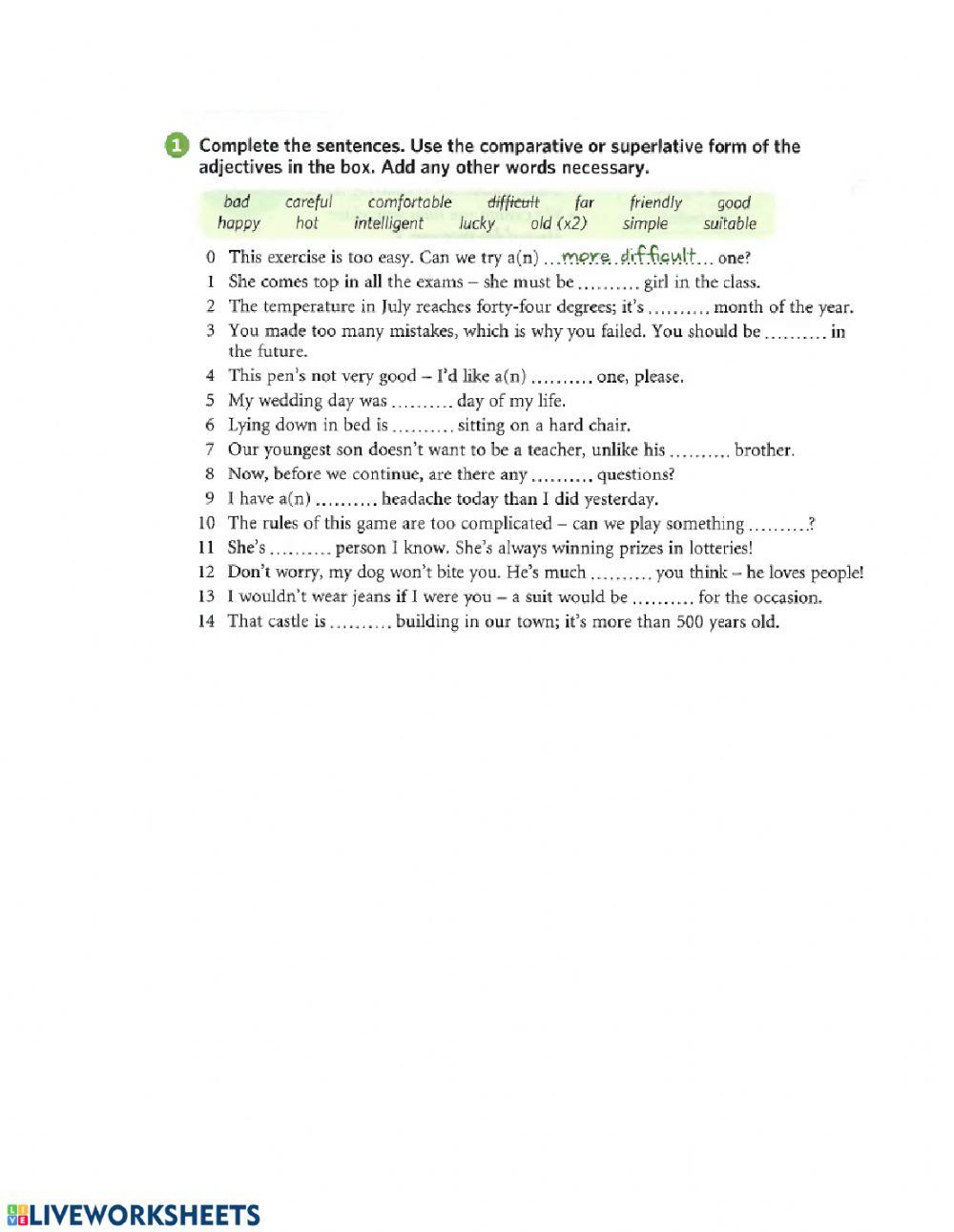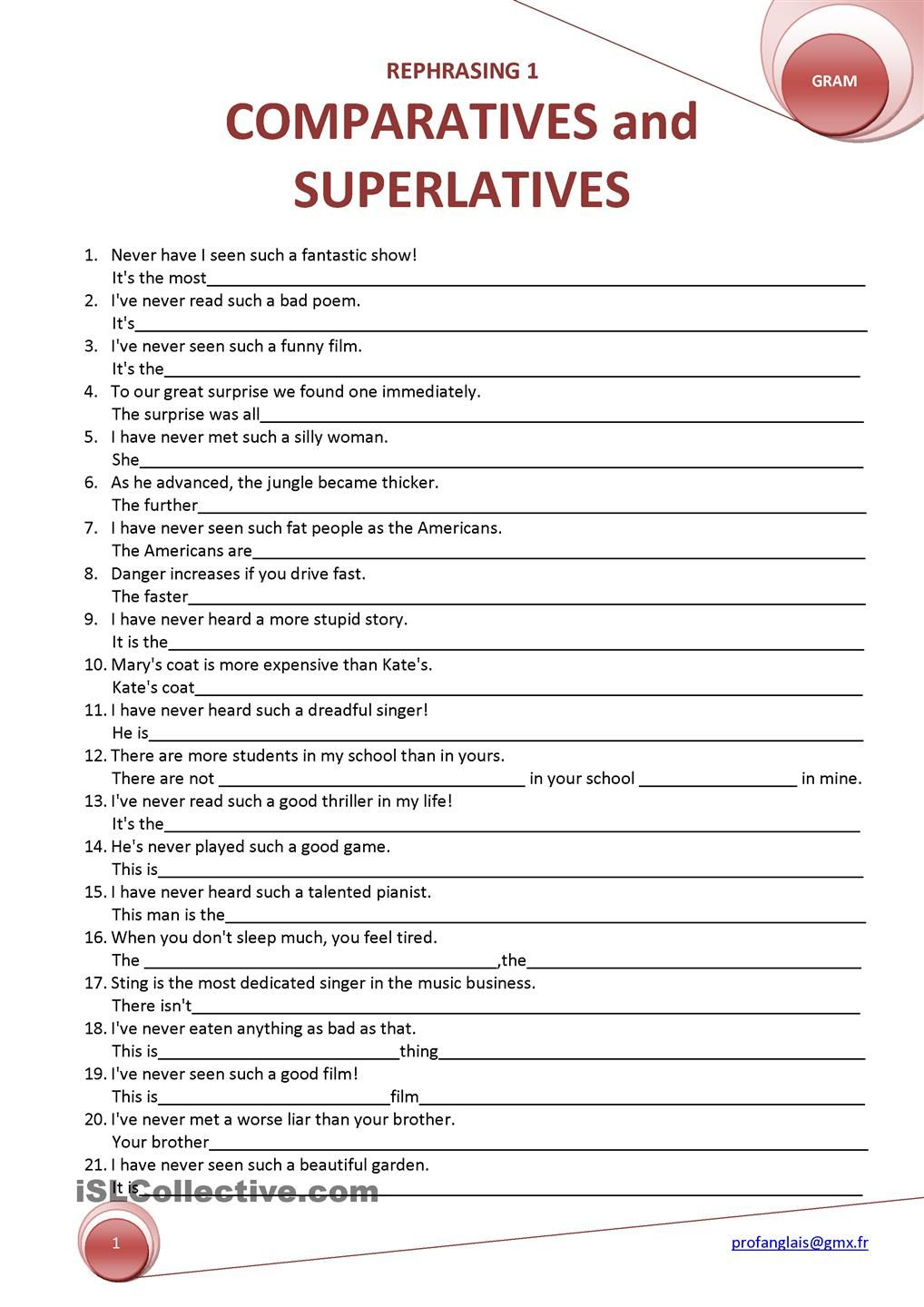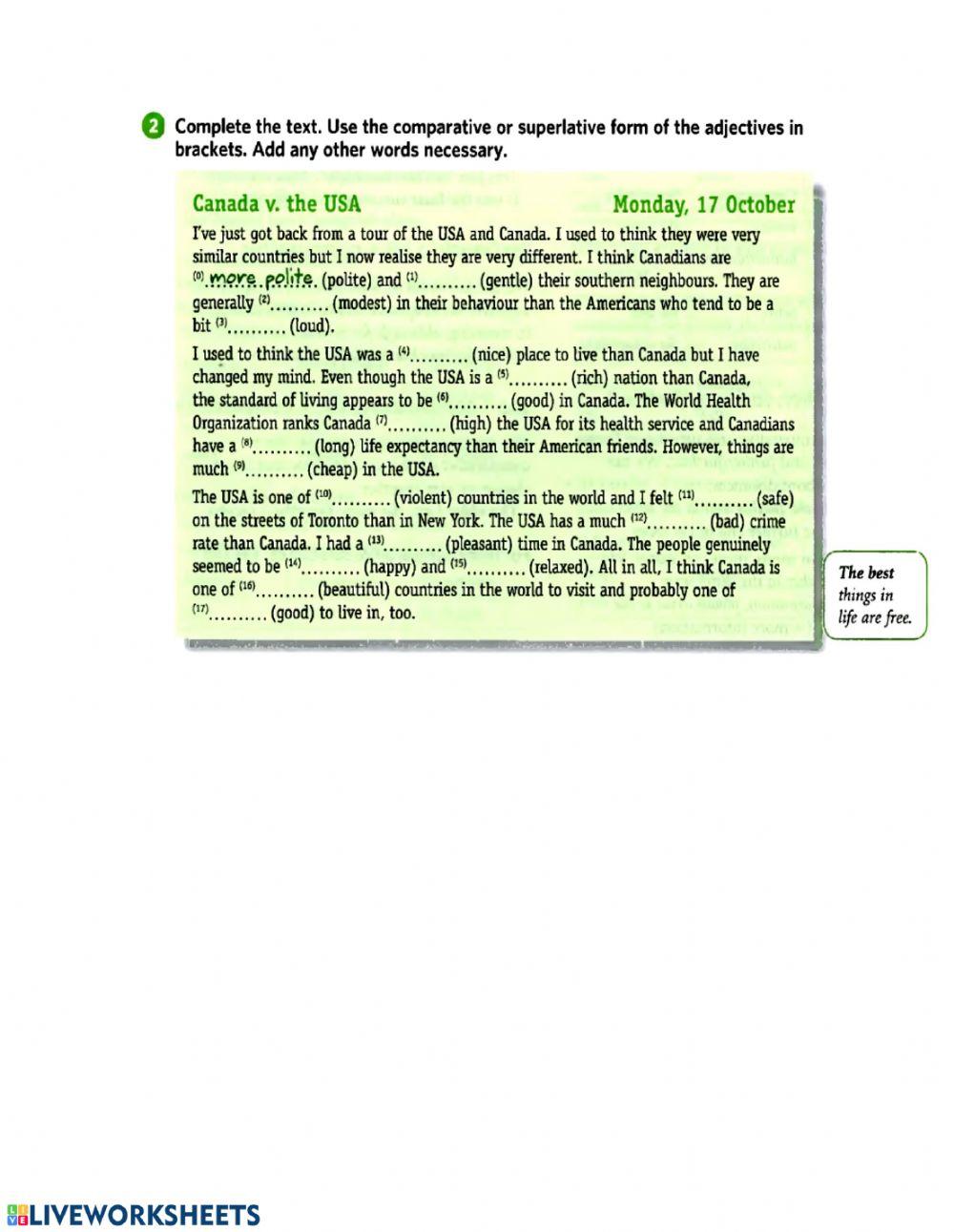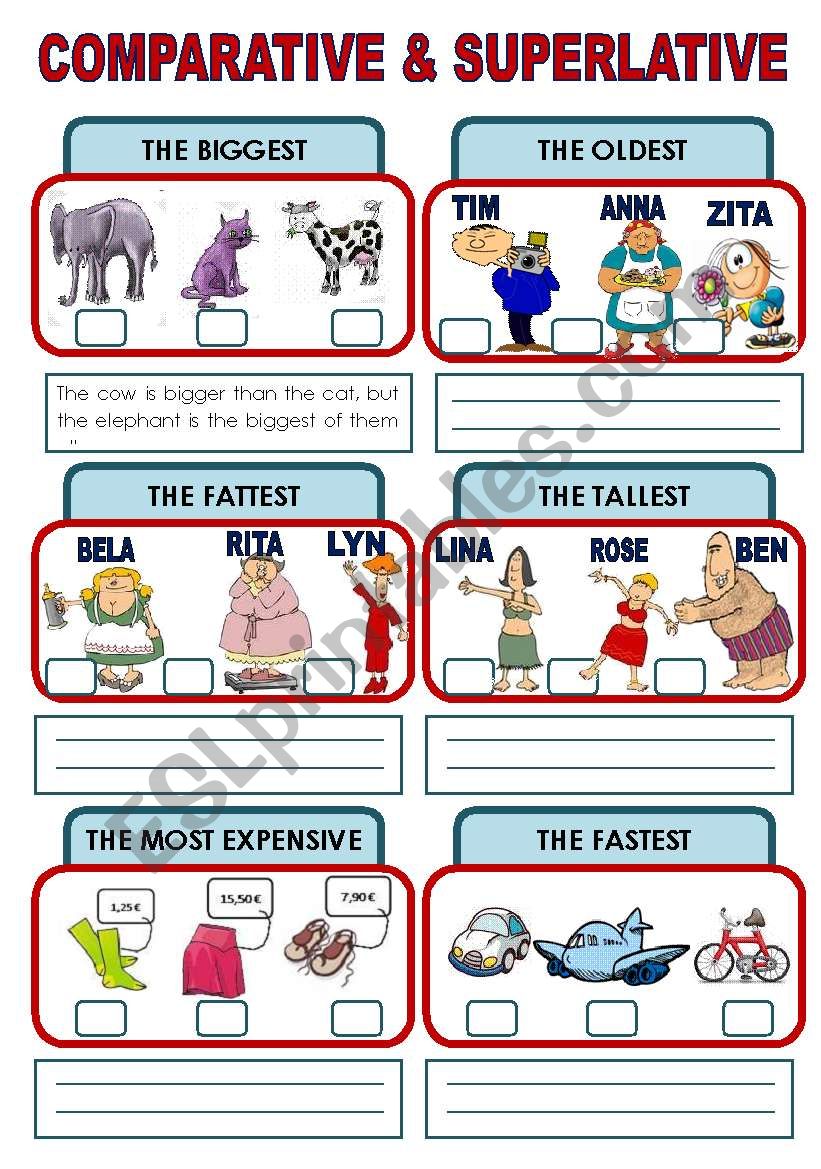
Mastering Nuance: The Indispensable Role of Comparative and Superlative B2 Worksheets
English language learning is a multifaceted journey, progressing from basic communication to nuanced expression. At the B2 (Vantage) level, learners are expected to navigate more complex grammatical structures, comprehend subtle differences in meaning, and produce coherent, detailed discourse. Among the grammatical areas that demand significant attention at this stage are comparatives and superlatives. While seemingly straightforward, their advanced application, especially in nuanced contexts, often presents a considerable challenge. This is where the strategic use of comparative and superlative B2 worksheets becomes not just helpful, but truly indispensable.
The B2 Landscape: Beyond the Basics

Before delving into the specifics of worksheets, it’s crucial to understand what distinguishes B2-level mastery of comparatives and superlatives from earlier stages. At A1/A2, learners grasp the basic forms: "bigger," "the biggest," "more interesting," "the most interesting." At B1, they might explore irregular forms like "better/best," "worse/worst," and "further/furthest," and perhaps touch upon the structure "as…as."

However, B2 demands a deeper understanding and more flexible application. Learners at this level need to:

- Handle complex sentences: Integrate comparative and superlative forms into longer, more intricate sentences, often involving clauses or other grammatical structures.
- Master nuanced expressions: Differentiate between "less important" and "not as important as," or understand the subtle implications of phrases like "the least popular" versus "not very popular."
- Utilize advanced comparative structures: Employ constructions like "the more…the more…" (e.g., "The harder you work, the luckier you get"), "much/far/a lot/a bit/slightly + comparative," and "one of the most/least."
- Avoid common B2 errors: Learners often overgeneralize rules (e.g., "more better," "most easiest"), struggle with adjective/adverb distinctions (e.g., "He drives more careful"), or misuse "than" and "that."
- Apply forms in diverse contexts: Use comparatives and superlatives not just for simple comparisons, but for expressing opinions, making arguments, describing trends, and evaluating choices.



A well-designed set of comparative and superlative B2 worksheets directly addresses these advanced requirements, providing targeted practice that moves beyond rote memorization to true application.
Why Worksheets Are Essential for B2 Comparatives and Superlatives

While communicative activities, debates, and presentations are vital at the B2 level, worksheets offer unique advantages that solidify grammatical understanding:
- Targeted Practice: Worksheets can isolate specific grammatical points, allowing learners to focus intensely on form and function without the added pressure of spontaneous conversation.
- Repetition and Reinforcement: Consistent exposure and practice with varied exercises help embed the rules and exceptions in long-term memory.
- Error Identification: Many worksheets are designed to highlight common errors, prompting learners to critically evaluate their own output.
- Scaffolding: Worksheets can gradually increase in difficulty, providing a structured path from recognition to controlled production.
- Self-Study Potential: High-quality worksheets with clear instructions and answer keys empower learners to take ownership of their learning outside the classroom.
- Assessment Tool: Teachers can use worksheets to gauge student comprehension and identify areas requiring further instruction.


The versatility of comparative and superlative B2 worksheets means they can be adapted for various learning styles and classroom scenarios, from individual homework assignments to pair work or group activities.
Types of Effective Comparative and Superlative B2 Worksheets
To truly cater to the B2 learner, comparative and superlative B2 worksheets must go beyond simple gap-fills. Here are several types that prove particularly effective:
-
Contextualized Gap-Fills with Nuance:
- Instead of isolated sentences, provide short paragraphs, dialogues, or even news snippets where learners fill in the correct comparative or superlative form. The context helps them understand the appropriate degree of comparison and choose between similar options (e.g., "less" vs. "not as much").
- Example: "The new smartphone is (innovative) than its predecessor, but it’s also (expensive) on the market. Many users found the battery life to be (disappointing) than expected, making it one of the (reliable) models this year."
-
Sentence Transformation/Rewriting:
- These exercises challenge learners to manipulate sentence structure while retaining or subtly altering meaning. This is excellent for practicing "as…as," "less…than," and "the…the" structures.
- Example:
- "My old car wasn’t as fast as my new one." → "My new car is ___ than my old one."
- "If you study a lot, you will learn a lot." → "The you study, you will learn."
- "No other building in the city is taller than this one." → "This is ___ building in the city."
-
Error Correction Worksheets:
- Present sentences containing common B2 errors related to comparatives and superlatives. This forces learners to actively identify and correct mistakes, reinforcing correct usage.
- Example: "Identify and correct the errors in the following sentences:
- She is more taller than her brother.
- That was the most easiest test I’ve ever taken.
- He drives more careful than anyone I know.
- The less money you spend, the more happy you’ll be."
-
Opinion and Argument Prompts (with scaffolding):
- These encourage productive use of the grammar in a communicative context, even if written. Provide a topic and ask learners to express opinions, compare options, or argue a point using a specified number of comparative/superlative forms.
- Example: "Write a short paragraph (5-7 sentences) comparing two popular tourist destinations. Use at least two comparative forms and one superlative form. Consider aspects like cost, attractions, climate, and local culture."
-
Situational Dialogues/Role-Play Preparation:
- Provide incomplete dialogues or scenarios where learners must choose the appropriate comparative/superlative to express preference, make a recommendation, or negotiate.
- Example: "You are helping a friend choose a new laptop. Look at the specifications of three different models (A, B, C). Write a short dialogue comparing their features (price, memory, battery life, screen size) to help your friend make the ‘best’ decision."
-
"The…the" Structure Focus:
- Dedicated exercises for this often tricky but high-frequency B2 structure.
- Example: Match the first half of a sentence with its correct second half:
- The older I get, ___ (a) the more tired I feel.
- The more you practice, ___ (b) the more delicious it tastes.
- The less you worry, ___ (c) the more fluent you become.
-
Descriptive Writing with Comparisons:
- Show a picture or a short video and ask learners to describe it, making comparisons between elements within the image/video using a variety of comparative and superlative forms. This integrates grammar with descriptive language.
Crafting Effective Comparative and Superlative B2 Worksheets
When designing or selecting comparative and superlative B2 worksheets, consider these pedagogical principles:
- Authenticity: Use realistic scenarios and language that B2 learners would encounter in everyday life, news, or academic contexts.
- Challenge, Not Overwhelm: The exercises should be challenging enough to promote growth but not so difficult that they cause frustration. Gradual increase in complexity is key.
- Variety is Key: Mix different exercise types within a single worksheet or across a series of worksheets to maintain engagement and cater to diverse learning styles.
- Clear Instructions: Ensure learners understand exactly what is expected of them.
- Provide Answer Keys: For self-study, a clear answer key is essential. In the classroom, this facilitates peer-correction and independent checking.
- Promote Critical Thinking: Design exercises that require learners to think beyond simple rule application, encouraging them to consider context, subtle meanings, and appropriate register.
- Integrate with Other Skills: Wherever possible, link the grammar practice to reading, writing, listening, or speaking tasks. For instance, a listening exercise could involve identifying comparative statements, followed by a writing task using those structures.
Beyond the Worksheet: Reinforcing Learning
While comparative and superlative B2 worksheets are invaluable, they are most effective when integrated into a broader learning strategy. Teachers can use them as:
- Pre-lesson warm-ups: To activate prior knowledge.
- In-class practice: For immediate application after a grammar explanation.
- Homework assignments: To consolidate learning independently.
- Review materials: Before tests or as refreshers.
Following worksheet completion, it’s crucial to bridge the gap to productive use. Encourage learners to apply the structures in:
- Debates and discussions: "Which is the most pressing global issue?"
- Presentations: "Comparing the benefits of two different technologies."
- Role-plays: "Negotiating the best deal."
- Writing tasks: Essays, reports, or reviews that require detailed comparisons.
Conclusion
The journey to B2 English proficiency demands a deep and flexible understanding of grammar, and comparatives and superlatives are no exception. By moving beyond basic forms to embrace nuanced expressions, complex structures, and contextual application, learners can significantly enhance their communicative abilities. The indispensability of high-quality comparative and superlative B2 worksheets lies in their capacity to provide targeted, varied, and challenging practice that solidifies this crucial grammatical foundation. When carefully selected and thoughtfully integrated into a comprehensive language learning curriculum, these worksheets serve as powerful tools, guiding B2 learners toward greater accuracy, fluency, and confidence in their English usage.
